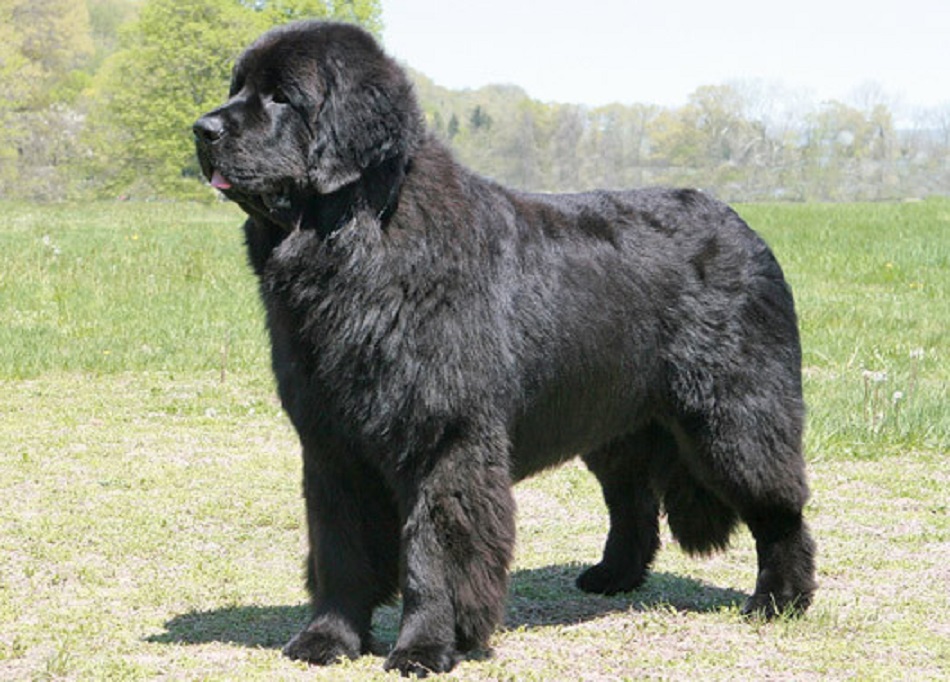
Newfoundland

Navigate through the tabs
Navigate through the tabs below to view the breed's info of your interest.
The breed's info is divided in four sections; namely:
the breed's history ,
the breed's main stats ,
the dog's potential health issues
and finally, how the breed scored in 26 different categories.
All the above information should give you a respectively good overview for the dog of your interest.
Dog Breed's Main Info
The Breed's History:
The Newfoundland comes from the Canadian province of the same name and worked alongside the fishermen of the area. Although originating in Canada, the details are sketchy.
There are three theories of how the Newfoundland came to be, though as is the case with most breeds, it's hard to validate. The first is that the Newfoundland is a cross between the Tibetan Mastiff and the now-extinct American Black Wolf.
Through the pairings of those two animals, the Newfoundland eventually evolved.
Another school of thought is that Vikings left the dogs when they visited the New World in 1000 A.D. and these dogs interbred and were eventually bred with wolves native to Eastern Canada.
The third theory is that the Newfoundland is the result of many European breeds cross bred around the 15th and 16th centuries, among them the Pyrenean Sheep Dogs, Mastiffs, and Portuguese Water Dogs.
What is known is that sometime in the late 18th century, Sir Joseph Banks, an English botanist, acquired several Newfoundlands and in 1775 George Cartwright named them. In the late 1800s, another fan, Professor Albert Heim of Switzerland identified and described the breed.
But the existence of the Newfie, as the breed is sometimes called, was in jeopardy until then. In the 1780s, the breed was almost wiped out because of government-imposed restrictions mandating that Canadian families had to pay taxes on the one dog they were allowed to keep.
One person who contributed to the Newfoundland's resurgence was Sir Edwin Landseer (1802-1873), who liked to include the Newfoundland in his paintings. The white and black variety of the Newfoundland was named Landseer in his honor.
But the future of the breed was truly solidified when the Honorable Harold MacPherson (1884-1963), governor of Newfoundland, made the dog his breed of choice.
In 1860, the first Newfoundland was shown in England. The breed was first registered with the American Kennel Club in 1879 and the first American Newfoundland champion was titled in 1883.
Country of Origin:
Newfoundland / England
Breed Group:
Working
Height:
2 feet, 1 inch. to 2 feet, 5 inches (63,5 to 73,66 cm)
Weight:
100 to 150 pounds (45,35 to 68,04 Kg)
Life Span:
8 to 10 years
Potential Health Issues:
Cherry Eye,
Hip Dysplasia,
Addison's Disease,
Subvalvular Aortic Stenosis,
Cataracts,
Hypothyroidism,
Epilepsy,
Elbow Dysplasia,
Cystinuria,
Cancer,
Gastric Torsion,
Ruptured Anterior Cruciate Ligament
Adaptability
Apartment Living:
First Time Owners:
Sensitivity:
Being Alone:
Cold Weather:
Hot Weather:
Friendliness
Affection With Family:
With Kids:
With Dogs:
With Strangers:
Health and Grooming
Shedding:
Drooling:
Easy To Groom:
Overall Health:
Weight Gain Potential:
Size:
Training
Easiness:
Intelligence:
Mouthiness:
Prey Drive:
Barking or Howling:
Wanderlust:
Need For Exercise
Energy Level:
Intensity:
Exercise Needs:
Playfulness:
Our Mobile Application
Check out Our Mobile Application "Dog Breeds Central"
